NTSE Level Test: The Human Eye & the Colourful World - CTET & State TET MCQ
25 Questions MCQ Test NCERT Textbooks (Class 6 to Class 12) - NTSE Level Test: The Human Eye & the Colourful World
Which is the correct condition for the total internal reflection to occur ?
If the angle of incidence is increased for a pair of air – glass interface, then the angle of refraction will
The lateral displacement of an incident ray passing out of a rectangular glass slab
A person developing near sightedness due to-
Which of the following phenomena is not the result of total internal reflection ?
Danger signals are red in colour because
A person cannot see distinctly any object placed beyond 40cm from his eyes. Calculate the power of the lens which will help him to see distant objects clearly.
Statement A : Improper functioning of rod shaped cells causes colour blindness
Statement B : The focal length of the human eye can be increased or decreased
A boy uses spectacles of focal length – 50cm. Hence the defect of vision, he is suffering from-
What happens to the image distance in the eye when we increase the distance of an object from the eye ?
The near point of a hypermetropic person is 75 cm if the person uses eye glasses having power +1.0D, Calculate the distance of distinct vision for him ?
What is the value of refractive index of the medium if the critical angle of incidence in a denser – rarer inter face is equal to 45° ?
Match the following with correct response.

Match the following with correct response.
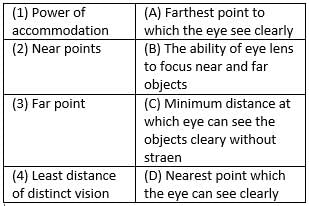
Match the following with correct response.
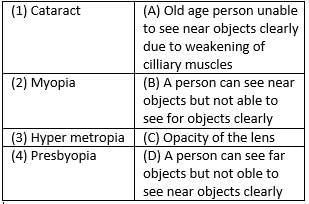
Match the following with correct response.
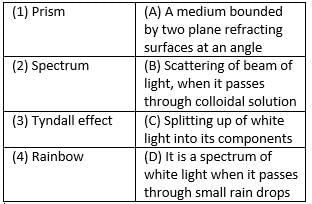
Match the following with correct response.

Match the following with correct response.
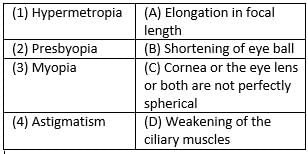
Match the following with correct response.

Match the following with correct response.
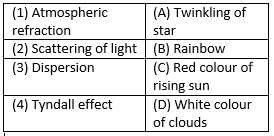
Match the following with correct response.

Which of following phenomena based on atmospheric refraction and total internal reflection
A. Sun appears to rise 2 minutes before and 2 minutes later
B. Stars seen higher than they actually are
C. Rainbow
D. Blue colour of clear sky
|
3 videos|687 docs|659 tests
|


















